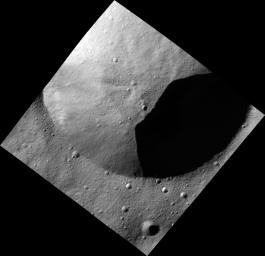
|
Crater in Shadow on Vesta
- Click the image above for a larger view
- Full-Res JPEG (1614 x 1559) (183.6 kB)
- Full-Res TIFF (1614 x 1559) (2.5 MB)
Caption:
This image, one of the first obtained by NASA's Dawn spacecraft in its low altitude mapping orbit, shows part of the rim of a fresh crater on the giant asteroid Vesta. The terrain shown here is located in an area known as the Heavily Cratered Terrain in the northern hemisphere.
The image, taken by Dawn's framing camera, is centered at around 17 degrees latitude and 77 degrees longitude. It was obtained on Dec. 13 at an altitude of 119 miles (191 kilometers). The image covers an area 11 miles by 11 miles (18 kilometers by 18 kilometers).
Background Info:
The Dawn mission to Vesta and Ceres is managed by NASA's Jet Propulsion Laboratory, a division of the California Institute of Technology in Pasadena, for NASA's Science Mission Directorate, Washington. UCLA is responsible for overall Dawn mission science. The Dawn framing cameras have been developed and built under the leadership of the Max Planck Institute for Solar System Research, Katlenburg-Lindau, Germany, with significant contributions by DLR German Aerospace Center, Institute of Planetary Research, Berlin, and in coordination with the Institute of Computer and Communication Network Engineering, Braunschweig. The framing camera project is funded by the Max Planck Society, DLR, and NASA/JPL.
More information about the Dawn mission is online at http://www.nasa.gov/dawn and http://dawn.jpl.nasa.gov .
Cataloging Keywords:
| Name | Value | Additional Values |
|---|---|---|
| Target | 4 Vesta | |
| System | Main Belt | |
| Target Type | Asteroid | |
| Mission | Dawn | |
| Instrument Host | Dawn | |
| Host Type | Orbiter | |
| Instrument | Framing Camera (FC) | |
| Detector | ||
| Extra Keywords | Crater, Grayscale, Shadow | |
| Acquisition Date | ||
| Release Date | 2011-12-21 | |
| Date in Caption | ||
| Image Credit | NASA/JPL-Caltech/UCLA/MPS/DLR/IDA | |
| Source | photojournal.jpl.nasa.gov/catalog/PIA15222 | |
| Identifier | PIA15222 | |
